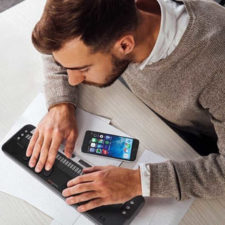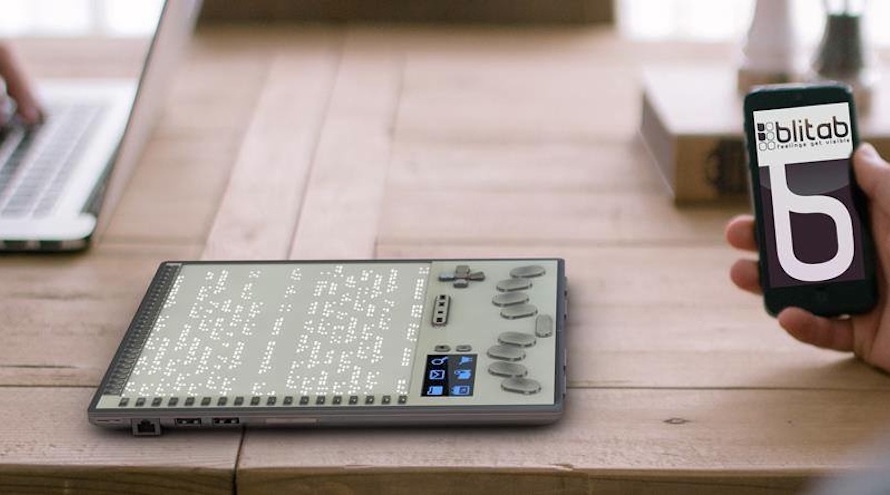A Guide to Life-Changing Assistive Innovation for the Blind and Visually Impaired
The development of assistive innovation has ushered in a transformative era for people that are blind or visually damaged, offering tools that boost freedom and enhance daily experiences. Innovations such as clever navigating gadgets and AI-driven applications are redefining exactly how users interact with their environments, while easily accessible reading options and wise home technologies assure to more raise the quality of life. As these technologies proceed to progress, one have to take into consideration not just their performances but additionally their effect on promoting independence and inclusivity. What does this mean for the future of accessibility?
Smart Navigation Devices
Smart navigating tools are transforming the means people that are blind or visually impaired interact with their atmosphere. These sophisticated technologies, which incorporate general practitioners, audio feedback, and haptic signals, provide users with important info about their environments, boosting their freedom and flexibility.
One prominent instance is using clever walking canes outfitted with sensing units that identify barriers and supply real-time responses via resonances or audio hints. These tools allow users to browse complicated atmospheres, such as busy roads or crowded public spaces, with enhanced confidence. In addition, wearable tools, such as wise glasses, are being developed to aid in identifying faces, checking out text, and recognizing things, even more augmenting the user's spatial recognition.
In addition, wise navigation devices are progressively incorporating expert system to evaluate data and adjust to individuals' preferences. This customized approach not just improves navigating effectiveness yet likewise fosters a feeling of empowerment amongst individuals. As innovation remains to development, the potential for smart navigation devices to produce a more easily accessible and inclusive globe for people who are blind or aesthetically impaired continues to be appealing, inevitably reshaping their daily experiences and communications.
Ingenious Mobile Applications
Mobile applications are emerging as powerful tools for helping individuals who are visually damaged or blind, supplying an array of capabilities that improve daily living. These applications harness progressed technology to assist in everyday tasks, boost ease of access, and advertise independence.
One classification of cutting-edge mobile apps focuses on aesthetic acknowledgment. Applications like Be My Eyes connect individuals with sighted volunteers via video telephone calls, making it possible for real-time help for jobs such as reviewing labels or navigating strange settings. Applications like Seeing AI make use of fabricated knowledge to explain surroundings, checked out text, and determine objects, supplying individuals with important info at their fingertips.
An additional significant area is navigation and alignment. Applications such as Aira and Close-by Traveler give audio assistance, assisting customers browse urban spaces effortlessly. They supply tailored aid, permitting a much more positive exploration of the environment.
In addition, wellness and health apps provide to certain requirements, such as medication management and health and fitness monitoring. These applications aim to foster an all natural method to well-being, making certain that users can maintain their health individually.
Wearable Assistive Instruments
Wearable assistive devices represent a substantial development in technology developed to sustain individuals that are blind or visually damaged. These devices improve wheelchair and freedom by offering real-time feedback regarding the surrounding setting. Among one of the most noteworthy wearable technologies are wise glasses equipped with sensing units and cams, which can identify barriers and relay crucial details through audio signs.

An additional innovative option includes wrist-worn devices that use ultrasonic waves to discover challenges and offer navigational assistance. These tools frequently feature personalized setups, enabling individuals to tailor the notifies to their details needs.
The assimilation of fabricated knowledge in wearable assistive innovation is likewise notable, as it constantly boosts the precision and responsiveness of these gadgets. In general, wearable assistive devices are changing the lives of the blind and visually damaged, fostering higher freedom and enhancing lifestyle via cutting-edge services.
Accessible Checking Out Solutions
Easily accessible analysis options play a crucial function in making it possible for individuals who are visually damaged or blind to involve with message across different layouts. These solutions encompass a variety of modern technologies and tools designed to enhance reading experiences, from standard print materials to digital material.
One prominent remedy is Optical Personality Acknowledgment (OPTICAL CHARACTER RECOGNITION) technology, which converts printed text into digital style, enabling individuals to listen to or check out the material utilizing display readers. Furthermore, specialized e-readers furnished with text-to-speech capacities supply personalized reading experiences, allowing customers to readjust font dimensions and background colors for boosted presence.
Another effective technique is braille display screens, which provide responsive responses by transforming digital text into braille. This allows individuals to review touch, cultivating greater independence and accessibility to literary works. Mobile applications made for reviewing checked papers or publications can empower individuals with instant accessibility to a vast library of products (OCR devices for the blind).

Smart Home Technologies
Smart home technologies have transformed the way people who are blind or aesthetically impaired engage with their living environments, improving both freedom and safety. These cutting-edge solutions take advantage of automation and connection to create an easily accessible space tailored to the demands of users.
Smart audio speakers and voice-activated aides provide hands-free control over different tools, permitting users to change temperature level, protection, and lights actions with straightforward voice commands. This capability minimizes reliance on sighted support and cultivates a feeling of freedom. In addition, clever lights systems can be customized to supply acoustic feedback or tactile hints, enabling individuals to navigate their homes much more efficiently.
Furthermore, safety systems outfitted with clever electronic cameras and sensors can explanation send out real-time notifies to users, enhancing personal safety without necessitating visual confirmation. Automated door locks provide satisfaction, enabling users to secure their homes easily.
Incorporating wise home innovations not only boosts everyday living however also encourages social communication with linked gadgets - Smart glasses for the visually impaired. With recurring improvements in assistive modern technology, the future appears promising, as more remedies will arise to further encourage individuals that are aesthetically damaged or blind, ensuring an extra inclusive and independent lifestyle
Final Thought
Finally, the developments in assistive technology for the blind and visually damaged represent a substantial leap toward boosting independence and lifestyle. Smart navigation devices, ingenious mobile applications, wearable tools, accessible reading solutions, and thin glasses wise home innovations jointly promote a comprehensive atmosphere. This assimilation of innovation not just improves flexibility and everyday living yet also equips people to involve totally with their environments, advertising greater autonomy and participation in society.
Technologies such as smart navigating tools and AI-driven applications are redefining how users connect with their surroundings, while accessible analysis remedies and smart home modern technologies promise to additional raise the top quality of life. As technology continues to development, the possibility for smart navigation devices to develop a much more comprehensive and right here obtainable world for people that are aesthetically impaired or blind stays promising, inevitably improving their everyday experiences and interactions.
Wearable assistive devices represent a significant development in innovation created to sustain people that are blind or aesthetically impaired. Amongst the most remarkable wearable modern technologies are clever glasses geared up with sensing units and electronic cameras, which can recognize barriers and relay important information via sound signs.
Smart navigation tools, cutting-edge mobile applications, wearable tools, easily accessible reading solutions, and clever home modern technologies jointly cultivate a comprehensive atmosphere.